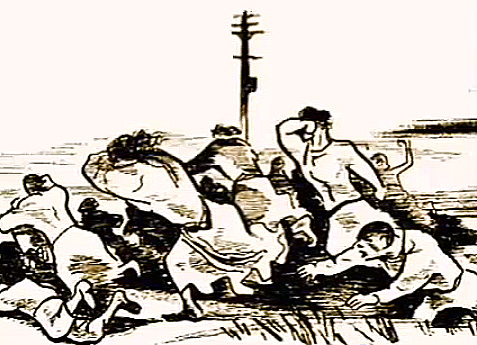
On June 19, 1937, police in Youngstown, Ohio, used tear gas on women and children, including at least one infant in his mother’s arms, during the historic strike at Republic Steel.
One union organizer recalled: “When I got there I thought the Great War had started over again. Gas was flying all over the place and shots flying and flares going up and it was the first time I had ever seen anything like it in my life.”
Some strikers were killed, and many others, including women and children, were injured. A reporter with the local press described how every time a worker peeked out from inside the steelworkers’ hall “somebody shot at them.”
According to the U.S. Senate’s LaFollette Civil Liberties Commission, which investigated the strike, 16 died and 283 were injured. [Between 1936 and 1941, the subcommittee published exhaustive hearings and reports on the use of industrial espionage, private police systems, strikebreaking services, munitions in industrial warfare, and employers’ associations to break strikes and to disrupt legal union activities in other ways.] In addition one policeman received a bullet wound and two birdshot wounds. Other sources report 17 deaths. Many of those killed were shot in the back while running from police.
The origins of the strike lie in the Great Depression that started nine years earlier. The National Industrial Recovery Act of 1933 encouraged collective bargaining in an effort to keep people working and production growing. In March 1937, the nation’s largest steelmaker, U.S. Steel, recognized the Steelworkers Organizing Committee (SWOC) as representative of its union employees.
A number of companies, however, including Republic Steel, Youngstown Sheet and Tube, Inland Steel and Bethlehem Steel and National – collectively known as Little Steel because of their small size individually compared to U.S. Steel, resented U.S. Steel’s actions and refused to recognize laws that gave workers the right to organize.
While Little Steel companies wanted to continue with representation committees that they controlled, the Wagner Act and the creation of the National Labor Relations Board in 1935 allowed that if a majority of workers voted for union representation, the company had to recognize and bargain with the union.
Republic and its anti-union chairman, Thomas Girdler, were willing to defy the law and use force to intimidate their workers. Their mills became armed camps. They declared war on their workers and made decisions that triggered an intense class battle. They had their own private police forces with plenty of weapons and ammunition, including machine guns. Republic and Youngstown Sheet and Tube purchased 160,000 rounds of ammunition for the Youngstown district.
The community got involved in a big way. There was a citizen’s committee’s full-page newspaper ad on June 19, titled, “The Individual’s Right in the Strike,” which read: “Not only do those who are employees in the mills suffer, the well being and happiness of thousands of other homes” are threatened.
It was not until 1941 that the Little Steel companies finally recognized unions. Republic was even forced to pay over $20 million in back pay for workers it had blacklisted in 1937.
Photo: From a drawing by William Gropper who was visiting Youngstown in 1937. Illustrating a video on the Little Steel Strike.










